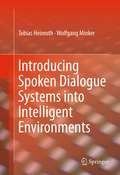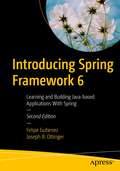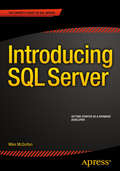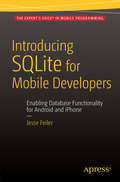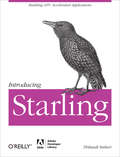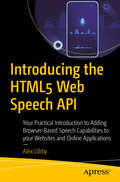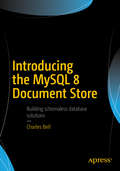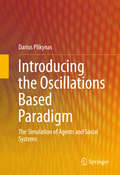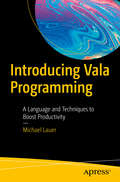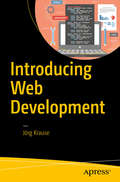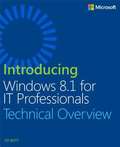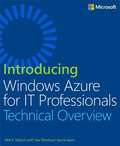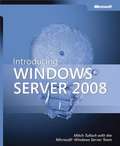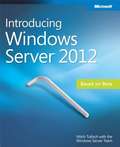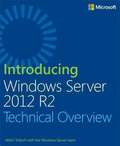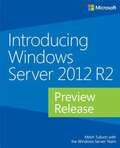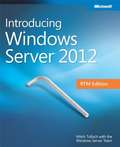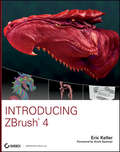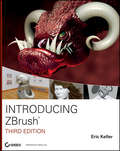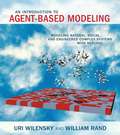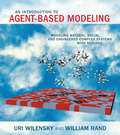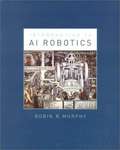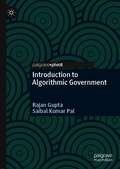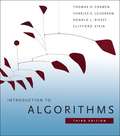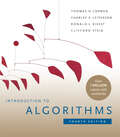- Table View
- List View
Introducing Spoken Dialogue Systems into Intelligent Environments
by Wolfgang Minker Tobias HeinrothIntroducing Spoken Dialogue Systems into Intelligent Environments outlines the formalisms of a novel knowledge-driven framework for spoken dialogue management and presents the implementation of a model-based Adaptive Spoken Dialogue Manager(ASDM) called OwlSpeak. The authors have identified three stakeholders that potentially influence the behavior of the ASDM: the user, the SDS, and a complex Intelligent Environment (IE) consisting of various devices, services, and task descriptions. The theoretical foundation of a working ontology-based spoken dialogue description framework, the prototype implementation of the ASDM, and the evaluation activities that are presented as part of this book contribute to the ongoing spoken dialogue research by establishing the fertile ground of model-based adaptive spoken dialogue management. This monograph is ideal for advanced undergraduate students, PhD students, and postdocs as well as academic and industrial researchers and developers in speech and multimodal interactive systems.
Introducing Spring Framework 6: Learning and Building Java-based Applications With Spring
by Felipe Gutierrez Joseph B. OttingerSpring Framework 6 remains - by far - the leading de-facto "out of the box" practical Java meta application development framework for building complex enterprise, cloud-native applications as well as web applications and microservices. Introducing Spring Framework 6 is your hands-on tutorial guide for learning the Spring Framework 6 from top to bottom, and allows you to build an example application along the way from the ground-up.As you learn the Spring Framework over the course of this book, you’llincrementally build your first Spring application piece-by-piece as you learn each module, project or component of the Spring Framework and its extensions and ecosystem. As you learn the various fundamentals, you'll then apply them immediately to your Spring application. This Spring application, My Documents, enables you to learn by doing. After reading this book, you will have the essentials you should need to start using the Spring Framework and building your own Java-based applications or microservices with it.What you'll learn:Get started with Spring Framework 6 by VMWare Tanzu and the Spring communityBuild your first My Documents application using Spring Framework and its extensionsTest your Spring applicationAdd persistence to your application using Spring Data JPA and moreShow your Spring application on the Web with Spring MVC and relatedUse REST APIs to enhance your application and add messaging with Kafka and AMQPIntegrate your Spring application with external systems using Spring Integration toolkitWho is this book for:This book is for those aspiring software developers and programmers who are new to Spring. Some prior programming experience recommended, preferably in Java.
Introducing SQL Server
by Mike McquillanIntroducing SQL Server is a fast and easy introduction to SQL Server and the world of relational databases. You'll learn how databases work and how to use the T-SQL language by practicing on one of the most widely-used and powerful database engines in the corporate world: Microsoft SQL Server. Do you quake at the sight of a SELECT statement? Start to shiver when people start talking about tables and rows? Fear not, Introducing SQL Server is here to rescue you. The book focuses on the knowledge and skills needed to begin your journey toward becoming a solid and competent SQL Server professional and database programmer. You'll learn the core concepts of SQL Server, from installing the software to executing and profiling queries. Introducing SQL Server is aimed at SQL Server newcomers as well as at those wanting to improve their database skills. You'll put a comprehensive database together as you work through the book. You will create tables and learn to use constraints; create reusable functions and stored procedures; and even learn how indexes work and what they bring in terms of increased performance. Introducing SQL Server shows you that databases don't need to be difficult. Teaches you how to build a SQL Server database from scratch Takes a tutorial-based approach, with each chapter building on the last Covers what you need to know for common SQL Server development tasks What you'll learn Install SQL Server and customize your system Build databases and table Become conversant with the T-SQL language Import data using text files and T-SQL Program in T-SQL, creating stored procedures and functions Administer SQL Server at a basic level, including query and index management Who this book is for Introducing SQL Server is for anybody who wants to learn how databases are put together in Microsoft SQL Server. It's especially helpful to database newcomers, software developers who want to improve their SQL Server knowledge, and those whose SQL knowledge has lapsed over time. Introducing SQL Server's unique tutorial-led approach makes it a great choice for those who enjoy learning by doing. It's also a great reference book to keep on your desk. Table of Contents Chapter 1: What is SQL Server? Chapter 2: Obtaining and Installing SQL Server Chapter 3: Database Basics Chapter 4: Tables Chapter 5: Putting Good Tables Together Chapter 6: Automating Deployment with SQLCMD Chapter 7: NULLs and Table Constraints Chapter 8: Inserts, Updates, and Deletes Chapter 9: Bulk Inserting Data Chapter 10: Creating Data Import Scripts Chapter 11: The SELECT Statement Chapter 12: Joining Tables Chapter 13: Views Chapter 14: Indexes Chapter 15: Transactions Chapter 16: Functions Chapter 17: Table-Valued Functions Chapter 18: Stored Procedures - Part 1 Chapter 19: Stored Procedures - Part 2 Chapter 20: Bits and Pieces Chapter 21: Appendix A: SQL Data Types Chapter 22: Appendix B: Glossary Chapter 23: Appendix C: Common SQL Server System Objects Chapter 24: Appendix D: Exercises
Introducing SQLite for Mobile Developers
by Jesse FeilerThis brief book is a basic introduction to SQLite for iOS and Android developers. The book includes a simple introduction to SQL, a discussion of when to use SQLite, and chapters devoted to using SQLite with the most likely programming languages: Java, PHP, Swift and Objective-C. It then goes through adding simple database functionality to an Android or iOS app and finally a chapter on managing the app's life cycle. What you'll learn What You Will Learn:The basics of SQLite The SQL you need to use SQLite effectively How to integrate database functionality into your mobile app. How to maintain the app Who this book is for This book is for Android or iOS developers who wish to use a lightweight but flexible database for their applications. It assumes mobile development experience but does not assume any database knowledge. Table of Contents 1. Getting Up to Speed with Databases and SQLite 2. Understanding What SQLite Is. . . 3. Working with the relationship model and SQLite 4. Using SQLite basics -- storing and retrieving data 5. Using SQLite features -- What you can do with SELECT statements 6. Using SQLite with PHP 7. Using SQLite with Java (Android) 8. Using SQLite with Swift (iOS/Mac) 9. Using SQLite with Objective-C (iOS/Mac) 10. Exploring the simple database (used in Chapters 10-12) 11. Using the simple database with a website (database example code included) 12. Adding the simple database to an Android app (using android. database. sqlite) 13. Adding the simple database to an iOS app (using Core Data) 14. Considering performance issues 15. Managing the SQLite life cyle
Introducing Starling
by Thibault ImbertStarling is an ActionScript 3 2D framework developed on top of the Stage3D APIs (available on desktop in Flash Player 11 and Adobe AIR 3). Starling is mainly designed for game development, but could be used for many other use cases. Starling makes it possible to write fast GPU accelerated applications without having to touch the low-level Stage3D APIs. Most Flash developers want to be able to leverage GPU acceleration (through Stage3D) without the need to write such higher-level frameworks and dig into the low-level Stage3D APIs. Starling is completely designed after the Flash Player APIs and abstracts the complexity of Stage3D (Molehill) and allows easy and intuitive programming for everyone. Obviously Starling is for ActionScript 3 developers, especially those involved in 2D game development; of course you will need to have a basic understanding of ActionScript 3. By its design (lightweight, flexible and simple), Starling can be used also be used for other use cases like UI programming. That said, everything is designed to be as intuitive as possible, so any JavaTM or .NetTM developer will get the hang of it quickly as well.
Introducing the HTML5 Web Speech API: Your Practical Introduction to Adding Browser-Based Speech Capabilities to your Websites and Online Applications
by Alex LibbyLeverage the power of HTML5 Web Speech API to quickly add voice capabilities to your websites. This project-oriented book simplifies the process of setting up and manipulating the API in the browser using little more than a text editor or free software. You'll be presented with a starting toolset that you can use to develop future projects, incorporate into your existing workflow and allow you to take your websites to the next level, reducing the reliance on entering choices through a keyboard and making the overall experience easier for customers. This excellent resource is perfect for getting acquainted with creating and manipulating browser-based APIs. You don’t have to convert your whole work process immediately; you can incorporate as little or as much as you want of the API, and build on this as your skills develop. We live in an age where speed and simplicity are of the essence – this book provides a perfect way to add speech capabilities to our websites, directly in the browser and with the minimum of fuss.Introducing the HTML5 Web Speech API is the right choice for developers who want to focus on simplicity to produce properly optimized content in modern browsers using tools already in their possession.What You'll Learn Implement the Web Speech API in a projectExplore some of the options for personalizing them for a projectGain an appreciation of pointers around user experience and how this affects the APIUnderstand how to manage issues and security when using the APIWork through some example projects, from standalone demos to implementing with other tools or libraries Who This Book Is For Website developers who are already familiar with JavaScript, and are keen to learn how to leverage the Web Speech API to quickly add voice-enabled capabilities to a website, using little more than a text editor. It’s ideal for those in agile development teams, where time is of the essence, and the pressure is on to deliver results quickly.
Introducing the MySQL 8 Document Store
by Charles BellLearn the new Document Store feature of MySQL 8 and build applications around a mix of the best features from SQL and NoSQL database paradigms. Don’t allow yourself to be forced into one paradigm or the other, but combine both approaches by using the Document Store. MySQL 8 was designed from the beginning to bridge the gap between NoSQL and SQL. Oracle recognizes that many solutions need the capabilities of both. More specifically, developers need to store objects as loose collections of schema-less documents, but those same developers also need the ability to run structured queries on their data. With MySQL 8, you can do both! Introducing the MySQL 8 Document Store presents new tools and features that make creating a hybrid database solution far easier than ever before. This book covers the vitally important MySQL Document Store, the new X Protocol for developing applications, and a new client shell called the MySQL Shell. Also covered are supporting technologies and concepts such as JSON, schema-less documents, and more. The book gives insight into how features work and how to apply them to get the most out of your MySQL experience. The book covers topics such as:The headline feature in MySQL 8MySQL's answer to NoSQLNew APIs and client protocolsWhat You'll LearnCreate NoSQL-style applications by using the Document StoreMix the NoSQL and SQL approaches by using each to its best advantage in a hybrid solutionWork with the new X Protocol for application connectivity in MySQL 8Master the new X Developer Application Programming InterfacesCombine SQL and JSON in the same database and applicationMigrate existing applications to MySQL Document StoreWho This Book Is ForDevelopers and database professionals wanting to learn about the most profound paradigm-changing features of the MySQL 8 Document Store
Introducing the Oscillations Based Paradigm
by Darius PlikynasThe book presents a conceptually novel oscillations based paradigm, the Oscillation-Based Multi-Agent System (OSIMAS), aimed at the modelling of agents and their systems as coherent, stylized, neurodynamic processes. This paradigm links emerging research domains via coherent neurodynamic oscillation based representations of the individual human mind and society (as a coherent collective mind) states. Thus, this multidisciplinary paradigm delivers an empirical and simulation research framework that provides a new way of modelling the complex dynamics of individual and collective mind states. This book addresses a conceptual problem - the lack of a multidisciplinary, connecting paradigm, which could link fragmented research in the fields of neuroscience, artificial intelligence (AI), multi-agent system (MAS) and the social network domains. The need for a common multidisciplinary research framework essentially arises because these fields share a common object of investigation and simulation, i. e. , individual and collective human behavior. Although the fields of research mentioned above all approach this from different perspectives, their common object of investigation unites them. By putting the various pathways of research as they are interrelated into perspective, this book provides a philosophical underpinning, experimental background and modelling tools that the author anticipates will reveal new frontiers in multidisciplinary research. Fundamental investigation of the implicit oscillatory nature of agents' mind states and social mediums in general can reveal some new ways of understanding the periodic and nonperiodic fluctuations taking place in real life. For example, via agent states-related diffusion properties, we could investigate complex economic phenomena like the spread of stock market crashes, currency crises, speculative oscillations (bubbles and crashes), social unrest, recessionary effects, sovereign defaults, etc. All these effects are closely associated with social fragility, which follows and is affected by cycles such as production, political, business and financial. Thus, the multidisciplinary OSIMAS paradigm can yield new knowledge and research perspectives, allowing for a better understanding of social agents and their social organization principles.
Introducing Vala Programming: A Language and Techniques to Boost Productivity
by Michael LauerGet an introduction into the Vala programming language and learn about its syntax, semantics, and idioms. Do you want to boost your productivity? Are you interested in a programming language that combines the efficiency of a scripting language with the performance of a compiled language? Did you always want to write GTK+ or GNOME programs, but hate C with a passion? Read this book and learn Vala!Introducing Vala Programming starts from Hello World and goes up to graphical user interfaces using GTK+, covering DBus interprocess communication, network programming, Linux specifics, and more. You’ll learn how to leverage external libraries and enhance Vala by writing bindings to new libraries.What You Will LearnDiscover the Vala programming language and how to use it to boost your productivityUse Vala syntax and semanticsWrite object-oriented code with ValaWork with DBusImplement networking with ValaIntegrate and use external libraries with bindings and libgusbWho This Book Is ForPeople with basic programming experience in any imperative programming language.
Introducing Web Development
by Jörg KrauseThis brief book is an easy-to-digest introduction to the key concepts of web development. Understand the concepts of the web and how they apply to static and dynamic websites. See how HTML and CSS are used to create the bones of the web. Concisely presented through four key concept chapters, Introducing Web Development will enable you to get a clear understanding of how web development works. What You Will LearnHow the web works and interacts with websitesWhat static and dynamic websites are and how they work How the static parts of a website are coded using HTML and CSSWho This Book Is ForAnyone who wants to understand the basics of web development.
Introducing Windows 8.1 For IT Professionals
by Ed BottNOTE: This title is also available as a free eBook. It is offered for sale in print format as a convenience. Get a head start evaluating Windows 8.1 - with early technical insights from award-winning journalist and Windows expert Ed Bott. Based on the Windows 8.1 Preview release, this guide introduces new features and capabilities, with scenario-based advice on how Windows 8.1 can meet the needs of your business. Get the high-level overview you need to begin preparing your deployment now. Preview new features and enhancements, including: How features compare to Windows 7 and Windows XP The Windows 8.1 user experience Deployment Security features Internet Explorer 11 Delivering Windows apps Recovery options Networking and remote access Managing mobile devices Virtualization Windows RT 8.1
Introducing Windows Azure for IT Professionals
by Mitch TullochNOTE: This title is also available as a free eBook. It is offered for sale in print format as a convenience. Get a head start evaluating Windows Azure - with technical insights from a Microsoft MVP Mitch Tulloch. This guide introduces the latest features and capabilities, with scenario-based advice on how the platform can meet the needs of your business. Get the high-level overview you need to begin preparing your deployment now. Topics include: Understanding Windows Azure Windows Azure Compute Services Windows Azure Network Services Windows Azure Data Services Windows Azure App Services Getting Started with Windows Azure
Introducing Windows Server® 2008
by Mitch Tulloch Microsoft Windows Server TeamGet a jump on evaluating Window Server 2008--with technical insights from Windows Server team. This practical introduction delivers real-world implementation scenarios and pragmatic advice for administering Windows Server in the enterprise. Discover how to: Deploy Windows Server 2008, and configure and manage server roles Understand Windows Server Virtualization Implement a single, integrated IDA solution built on Active Directory Explore enhancements in Internet Information Services 7.0 Use failover clustering for high-availability solutions Implement the Network Access Protection platform
Introducing Windows Server® 2012
by Mitch TullochGet a head start evaluating Window Server 2012--with technical insights from a Microsoft MVP who's worked extensively with the beta release. This practical introduction illuminates new features and capabilities, with scenarios demonstrating how the platform can meet the needs of your business. Based on beta software, this book provides the early, high-level information you need to begin preparing now for deployment and management. Topics include:Virtualization and cloud solutions Availability Provisioning and storage management Security and scalability Infrastructure options Server administration
Introducing Windows Server 2012 R2
by Mitch TullochNOTE: This title is also available as a free eBook on the Microsoft Download Center. It is offered for sale in print format as a convenience. Get a head start evaluating Windows Server 2012 R2 - with technical insights from a Microsoft MVP and members of the Windows Server product team. Based on final Windows Server 2012 R2 release-to-manufacturing (RTM) software, this guide introduces new features and capabilities, with scenario-based advice on how the platform can meet the needs of your business. Get the high-level overview you need to begin preparing your deployment now. Coverage includes: Server virtualization and cloud solutions Availability and scalability Provisioning and storage management Security features, access, and data protection Infrastructure options Server management and automation
Introducing Windows Server 2012 R2 Preview Release
by Mitch TullochNOTE: This title is also available as a free eBook on the Microsoft Download Center. It is offered for sale in print format as a convenience. Get a head start evaluating Windows Server 2012 R2 - with early technical insights from a Microsoft MVP and members of the Windows Server product team. Based on the Windows Server 2012 R2 Preview release, this guide introduces new features and capabilities, with scenario-based advice on how the platform can meet the needs of your business. Get the high-level overview you need to begin preparing your deployment now. Preview new features and enhancements, including: Server virtualization and cloud solutions Availability and scalability Provisioning and storage management Security features, access, and data protection Infrastructure options Server management and automation
Introducing Windows Server® 2012 RTM Edition
by Mitch TullochGet a head start evaluating Window Server 2012--with technical insights from a Microsoft MVP who's worked extensively with the beta release. This practical introduction illuminates new features and capabilities, with scenarios demonstrating how the platform can meet the needs of your business. Based on final, release-to-manufacturing (RTM) software, this book provides the high-level information you need to begin preparing now for deployment and management. Topics include:Virtualization and cloud solutions Availability Provisioning and storage management Security and scalability Infrastructure options Server configuration and administration
Introducing ZBrush
by Eric KellerIf you want to take advantage of one of the hottest CG tools available, Introducing ZBrush is the perfect place to start.Introducing ZBrush helps you jump into this exciting drawing and sculpting software without fear. Learn ZBrush 3.1 basics inside and out and get comfortable sculpting in a digital environment with this relaxed, friendly, and thorough guide. Master these practical techniques and soon you'll be creating realistic, cartoon, and organic models with flair.Introduces you to ZBrush 3.1, the sculpting software that lets you create digital art with a fine-art feel, which you can transfer into Maya or other 3D applicationsCovers painting, meshes, organic sculpting, hard surface sculpting, textures, lighting, rendering, working with other 3D applications, and scriptingWalks you through a series of fun and engaging tutorials where you can start creating your own work, including human, cartoon, and organic modelsLearn to create lush, beautiful digital art with ZBrush and this detailed guide.
Introducing ZBrush 3rd Edition
by Eric KellerLearn ZBrush inside and out with this updated new editionGet totally comfortable sculpting in a digital environment with the latest edition of this bestselling beginner's guide to ZBrush. Fully updated for the newest version of the software, ZBrush 4R3, this book dispels any fears you might have about the difficulty of using ZBrush and soon has you creating realistic, cartoon, and organic models with flair. Learn all the essentials, as you complete fun tutorials on painting, meshes, organic scripting, hard surface sculpting, lighting, rendering, and more.Introduces you to ZBrush, the sculpting software that lets you create digital art with a fine-art feel, which you can transfer into Maya or other 3D applications Covers painting, meshes, organic sculpting, hard surface sculpting, textures, lighting, rendering, working with other 3D applications, and scripting Walks you through a series of fun and engaging tutorials where you can start creating your own work, including human, cartoon, and organic models Fully updated for the newest version of ZBrush, ZBrush 4R3, including full coverage of its robust rendering tools Includes a DVD with helpful video examples and files to help you complete the tutorialsDesign remarkably realistic creatures, people, and objects with ZBrush and the new edition of this top-selling guide.The DVD is not included as part of the e-book file, but is available for download after purchase.
An Introduction to Agent-Based Modeling: Modeling Natural, Social, and Engineered Complex Systems with NetLogo
by Uri Wilensky William RandThe advent of widespread fast computing has enabled us to work on more complex problems and to build and analyze more complex models. This book provides an introduction to one of the primary methodologies for research in this new field of knowledge. Agent-based modeling (ABM) offers a new way of doing science: by conducting computer-based experiments. ABM is applicable to complex systems embedded in natural, social, and engineered contexts, across domains that range from engineering to ecology. An Introduction to Agent-Based Modeling offers a comprehensive description of the core concepts, methods, and applications of ABM. Its hands-on approach -- with hundreds of examples and exercises using NetLogo -- enables readers to begin constructing models immediately, regardless of experience or discipline.The book first describes the nature and rationale of agent-based modeling, then presents the methodology for designing and building ABMs, and finally discusses how to utilize ABMs to answer complex questions. Features in each chapter include step-by-step guides to developing models in the main text; text boxes with additional information and concepts; end-of-chapter explorations; and references and lists of relevant reading. There is also an accompanying website with all the models and code.
An Introduction to Agent-Based Modeling: Modeling Natural, Social, and Engineered Complex Systems with NetLogo
by Uri Wilensky William RandA comprehensive and hands-on introduction to the core concepts, methods, and applications of agent-based modeling, including detailed NetLogo examples. The advent of widespread fast computing has enabled us to work on more complex problems and to build and analyze more complex models. This book provides an introduction to one of the primary methodologies for research in this new field of knowledge. Agent-based modeling (ABM) offers a new way of doing science: by conducting computer-based experiments. ABM is applicable to complex systems embedded in natural, social, and engineered contexts, across domains that range from engineering to ecology. An Introduction to Agent-Based Modeling offers a comprehensive description of the core concepts, methods, and applications of ABM. Its hands-on approach—with hundreds of examples and exercises using NetLogo—enables readers to begin constructing models immediately, regardless of experience or discipline. The book first describes the nature and rationale of agent-based modeling, then presents the methodology for designing and building ABMs, and finally discusses how to utilize ABMs to answer complex questions. Features in each chapter include step-by-step guides to developing models in the main text; text boxes with additional information and concepts; end-of-chapter explorations; and references and lists of relevant reading. There is also an accompanying website with all the models and code.
Introduction to AI Robotics
by Robin R. MurphyThis text covers all the material needed to understand the principles behind the AI approach to robotics and to program an artificially intelligent robot for applications involving sensing, navigation, planning, and uncertainty. Robin Murphy is extremely effective at combining theoretical and practical rigor with a light narrative touch. In the overview, for example, she touches upon anthropomorphic robots from classic films and science fiction stories before delving into the nuts and bolts of organizing intelligence in robots. Following the overview, Murphy contrasts AI and engineering approaches and discusses what she calls the three paradigms of AI robotics: hierarchical, reactive, and hybrid deliberative/reactive. Later chapters explore multiagent scenarios, navigation and path-planning for mobile robots, and the basics of computer vision and range sensing. Each chapter includes objectives, review questions, and exercises. Many chapters contain one or more case studies showing how the concepts were implemented on real robots. Murphy, who is well known for her classroom teaching, conveys the intellectual adventure of mastering complex theoretical and technical material.
Introduction to Algorithmic Government
by Rajan Gupta Saibal Kumar PalThe world is changing at a fast pace, so is the Government and Governance style. Humans are bound to go for Algorithmic strategies rather than manual or electronic ones in different domains. This book introduces the Algorithmic Government or Government by Algorithm, which refers to authorizing machines in the Public Sector for automated decision-making based on Artificial Intelligence, Data Science, and other technologies. It is an emerging concept introduced globally and will be considered revolutionary in the future. The book covers concepts, applications, progress status, and potential use-cases of Algorithmic Government. This book serves as introductory material for the readers from technology, public policy, administration, and management fields.
Introduction to Algorithms
by Thomas H. Cormen Charles E. Leiserson Ronald L. Rivest Clifford SteinSome books on algorithms are rigorous but incomplete; others cover masses of material but lack rigor. Introduction to Algorithms uniquely combines rigor and comprehensiveness. The book covers a broad range of algorithms in depth, yet makes their design and analysis accessible to all levels of readers. Each chapter is relatively self-contained and can be used as a unit of study. The algorithms are described in English and in a pseudocode designed to be readable by anyone who has done a little programming. The explanations have been kept elementary without sacrificing depth of coverage or mathematical rigor.
Introduction to Algorithms, fourth edition
by Thomas H. Cormen Charles E. Leiserson Ronald L. Rivest Clifford SteinA comprehensive update of the leading algorithms text, with new material on matchings in bipartite graphs, online algorithms, machine learning, and other topics.Some books on algorithms are rigorous but incomplete; others cover masses of material but lack rigor. Introduction to Algorithms uniquely combines rigor and comprehensiveness. It covers a broad range of algorithms in depth, yet makes their design and analysis accessible to all levels of readers, with self-contained chapters and algorithms in pseudocode. Since the publication of the first edition, Introduction to Algorithms has become the leading algorithms text in universities worldwide as well as the standard reference for professionals. This fourth edition has been updated throughout. New for the fourth edition • New chapters on matchings in bipartite graphs, online algorithms, and machine learning • New material on topics including solving recurrence equations, hash tables, potential functions, and suffix arrays • 140 new exercises and 22 new problems • Reader feedback–informed improvements to old problems • Clearer, more personal, and gender-neutral writing style • Color added to improve visual presentation • Notes, bibliography, and index updated to reflect developments in the field • Website with new supplementary material
